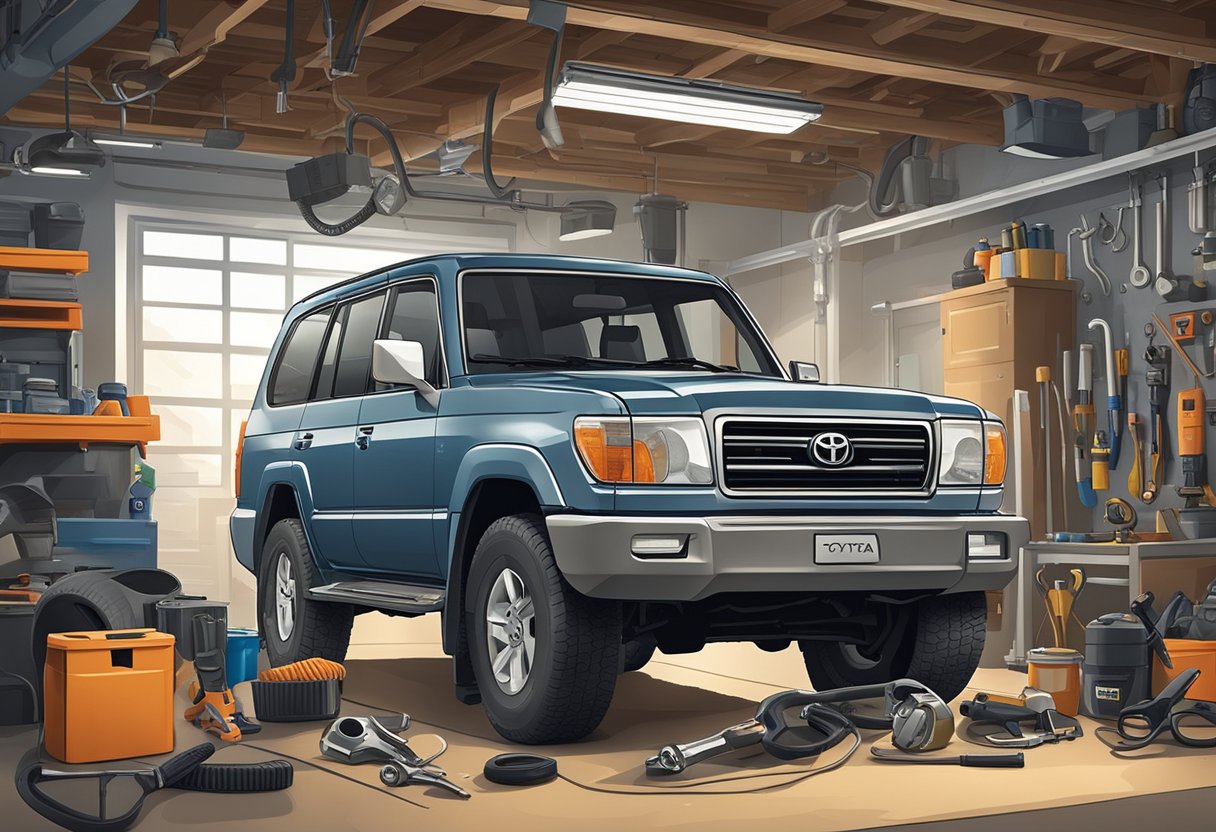*This post may contain affiliate links. As an Amazon Associate we earn from qualifying purchases.
Maintaining a Toyota Land Cruiser is akin to caring for a loyal steed; it’s all about the timing (belt). If your Land Cruiser could speak, it would probably remind you that the timing belt is a vital component that needs regular check-ins to prevent it from throwing a wrench into your engine’s harmony. Knowing when to change the timing belt on your Toyota Land Cruiser isn’t just a matter of mileage—it’s an investment in your vehicle’s longevity and your peace of mind.

As one of the undisputed kings of off-road prowess, the Toyota Land Cruiser demands respect for its mechanics, especially the timing belt. The belt is a crucial player in the symphony of pistons, valves, and gears. Ignore its swan song, and you might find yourself serenading the tow truck driver instead. Your vehicle’s maintenance guide, coupled with a keen ear for unusual engine noise, are your duet partners in ensuring your timing belt gets an encore before its final curtain call.
Key Takeaways
- Timing belt maintenance is critical for the Toyota Land Cruiser’s performance.
- Replacement intervals depend on mileage and signs of wear.
- Vigilance and regular checks can avoid expensive repairs.
The Timely Tale of Timing Belts
https://www.youtube.com/watch?v=sncNFdM0kl0&embed=true
A Toyota Land Cruiser’s timing belt is more than just a component; it’s the unsung hero steering the harmony inside the engine. Without the correct and timely care of this vital part, one’s trusty ride could turn into a rather large paperweight.
Not All Heroes Wear Capes: The Role of the Timing Belt
The timing belt might seem like a mere strip of rubber, but it’s actually the maestro of your engine’s symphony, coordinating the dance between the pistons and valves. It ensures that the internal components of one’s Toyota Land Cruiser’s engine meet in pitch-perfect synchrony rather than in a catastrophic collision.
It’s All in the Timing: When to Change Your Belt
Toyota Land Cruiser owners should note two key factors when planning a timing belt replacement – mileage and time. While these belts are tough, they’re not invincible and should get retire at the right intervals.
- For models between 1980-2021, the timing belt should be replaced based on two criteria:
- Mileage: Every 60,000 to 90,000 miles
- Time: Roughly every 6 years, even if mileage is low
By the Numbers:
| Model Years | Mileage | Time |
|---|---|---|
| 1980 – 2021 | 60,000 – 90,000 miles | 6 years |
Replacing one’s timing belt might not be the most exhilarating saga in the grand story of automobile maintenance, but doing so promptly is an act of heroism for the Land Cruiser’s engine.
Decoding the Symptoms: Is Your Land Cruiser Crying for Help?
https://www.youtube.com/watch?v=UhI_B59lefo&embed=true
If your Toyota Land Cruiser’s performance seems off, it may be sending SOS signals in the form of unusual noises or illuminated dashboard lights. Trust us, it’s not trying to serenade you or throw a disco; it’s time to play detective!
Squeaks & Squeals: Understanding Warning Signs
The Land Cruiser isn’t shy about voicing its discomfort. When it starts to whine more than a teenager asked to do chores, it could be the timing belt serenading you with the sweet, screechy ballads of distress. Pay attention to these acoustic solos:
- Squealing from Under the Hood: Like a karaoke performance gone wrong, if it’s making your ears hurt, it’s not normal.
- Subtle Squeaks While Cruising: It’s not trying to communicate in rodent language; it might be the timing belt’s swan song.
Oracle of the Owner’s Manual: The Service Sage
They say wisdom comes with age, but in the case of a Land Cruiser, it comes with the owner’s manual. This sacred tome often holds the keys to the maintenance mysteries, including the mystical timelines for timing belt replacement. Here’s what the ancient text typically prescribes:
- Mileage Milestones: It’s usually crystal clear about when to swap out the timing belt—often between every 60,000 to 100,000 miles.
- Time Triggers: But wait, there’s more! Age can be just as cruel to timing belts as it is to rock stars, so even if the miles are low, time might dictate a change. Consult the manual posthaste!
The Operation: Replacing the Timing Belt
https://www.youtube.com/watch?v=zRPhl1xcYYw&embed=true
Replacing the timing belt on a Toyota Land Cruiser is like coordinating a pit stop in an endurance race: precision and timing are key. The mechanic, akin to a skilled pit crew, must navigate the engine’s intricacies and have their toolkit ready to go.
World Tour of the Engine: Accessing the Timing Belt
Cracking open the Land Cruiser’s engine cover, the mechanic embarks on a delicate dance around the engine bay. They’re greeted by a maze of components, which requires them to follow a specific path to reach the elusive timing belt. The task entails removing various obstacles, which might include the serpentine belt, engine mounts, and potentially part of the cooling system to clear the way.
Gathering the Team: Required Parts and Tools
Before diving under the hood, one must ensure all the necessary accomplices have been assembled. Here’s what the mechanic’s lineup should look like:
- Timing Belt Kit: This star player includes a new timing belt and often comes with a new tensioner and idler pulleys.
- Water Pump: Often replaced with the timing belt, as it sits nearby and they share a similar lifespan.
- Tools: Wrench sets, screwdrivers, and a harmonic balancer puller are just a few of the must-haves.
- Manual: The vehicle’s service manual – a treasure trove of torque specs and alignment marks.
Below is a brief inventory of what’s needed:
| Item | Quantity |
|---|---|
| Timing Belt | 1 |
| Tensioner | 1 |
| Idler Pulleys | 2 |
| Water Pump | 1 |
| Wrench Set | 1 |
| Screwdrivers | Various sz |
| Pulley Puller | 1 |
With a whiff of grease in the air and a band of tools at their side, the mechanic is ready to conquer the timing belt replacement, ensuring the Land Cruiser can keep up its voyages without skipping a beat.
Post-Op Care & Feeding: Maintaining Your Cruiser

After your Cruiser has had its “surgery” – a timing belt replacement – it’s time to think about the recovery diet and exercise plan. Here’s how one can keep the trusty steed, the Toyota Land Cruiser, in tip-top shape after such a crucial service:
First up, let’s talk about the routine check-ups:
- Oil changes: Just like morning coffee for humans, fresh oil is the daily kickstarter for the Cruiser’s engine.
- Brake inspections: Nobody likes a close call; ensure those brakes are in primo condition.
- Tire rotations: Even tread wear keeps the ride smooth and the rubber on the road.
Now, it’s feeding time! The Cruiser’s appetite includes:
- High-quality engine oil: It prefers the good stuff, not the discount dollar store variety.
- Coolant: Keep it cool under the hood because nobody enjoys a hot-headed Cruiser.
- Transmission fluid: It ensures smooth gear shifts, making any climb feel like a walk in the park.
Here’s a little cheat sheet to stick on your fridge:
| Service | Engine TLC | Vehicle Fitness |
|---|---|---|
| Timing Belt | Check every 100,000 km or earlier if it starts to complain. | If ignored, it might throw a fit and break down. |
| Fluids check | It’s thirsty work being an engine; quench its thirst every service. | Keeping fluids topped up means a happy, hydrated vehicle. |
Remember, a well-maintained Cruiser is a joyous one, echoing its content engine purr all over the neighborhood. If one listens closely, it’s almost as if it’s saying, “Thanks, pal, for the TLC. Let’s go on an adventure!”
